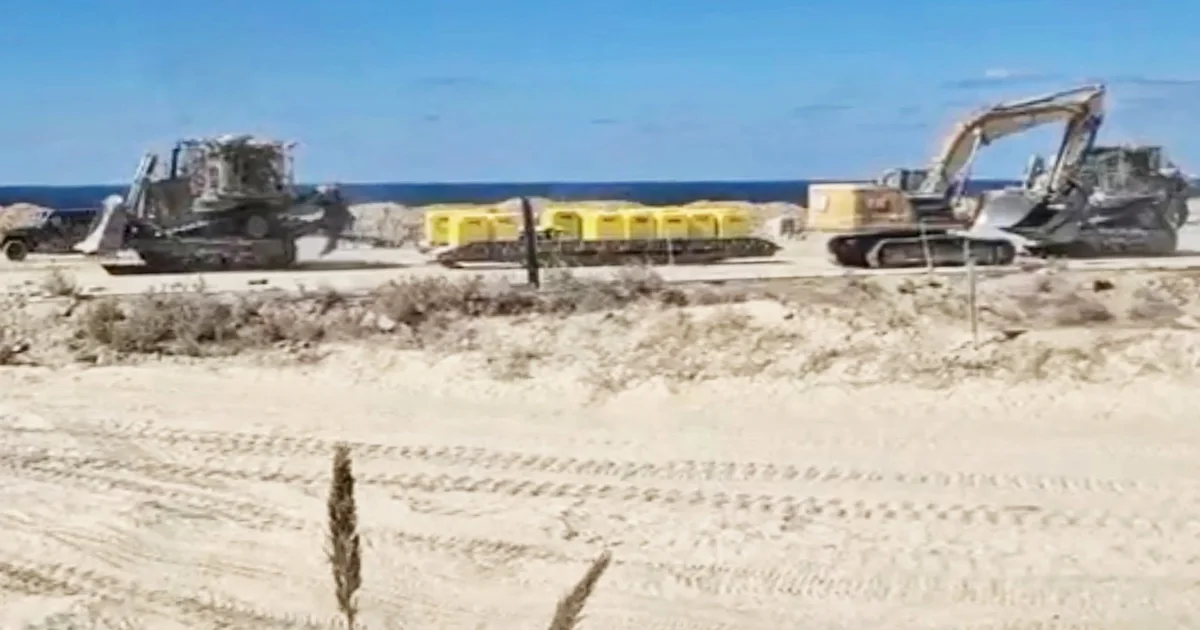Copyright NBC News

The blocks are concrete — but little else about Israel's "yellow line" appears to be. Israeli troops have laid yellow blocks down on the ground in Gaza, marking the parts of the Palestinian enclave — just more than half of the territory — still under their control as part of the ceasefire with Hamas. Envisioned as a temporary boundary under the first phase of the agreement, which was brokered in part by President Donald Trump, the line has instead become a flashpoint. Israel carried out days of strikes on Gaza last week despite the truce, killing more than 100 people, including dozens of children, according to the Palestinian Health Ministry in Gaza, Israel said it was responding to what it said was a Hamas attack that killed one of its soldiers operating within the "yellow line." Hamas denied involvement. Israeli forces had earlier separately opened fire on Palestinians in incidents in which it said people neared or crossed the boundary line prior to physical barriers being put in place. The next stages of Trump's plan that would see Israel withdraw further are still to be negotiated. Israeli Prime Minister Benjamin Netanyahu's office said Monday that he met with senior White House officials to discuss efforts to further implement Trump's 20-point plan. Analysts warned that with the future of the truce appearing to be on “shaky” ground, it could be some time before there is clarity. NBC News spoke to some Palestinians whose homes, or what's left of them, lie just beyond the barrier. For them, the line has become a physical manifestation of their fears that they may never be able to return to their land. 'I can't even look at it' The Israel Defense Forces began laying the yellow markers last month in what the military said was an effort to clearly delineate the areas it had agreed to withdraw to under the ceasefire deal with Hamas, which came into effect Oct. 10. It came after repeated incidents of Israeli forces firing upon Palestinians who they said had approached or crossed the withdrawal boundary, dubbed the “yellow line." In one case last month, the Gaza Civil Defense agency said Israeli forces had killed nine people in a bus. The Israeli military said troops initially fired warning shots at the vehicle, which it said had crossed the boundary, and then "opened fire to remove the threat" when the vehicle didn't stop. But for Medhat Ismail al-Shawaf, who said his home in Abasan al-Kabira in southern Gaza lies just beyond the boundary, the markers added fuel to long-standing fears over when he and his family would be able to return to their land. “We cannot return to our homes because of the yellow line drawn by the occupying army,” al-Shawaf, 32, said in an interview last week from Khan Younis. He has been sheltering there amid the ceasefire with his wife, Mona al-Shawaf, 30, and their three children. “I can’t reach it, and I can’t even look at it from afar due to the current circumstances,” he said, adding that he felt "pessimistic" about how the truce in Gaza would play out. After the ceasefire was announced, he said, the family was briefly able to return to their home, only to find it “partly demolished and unlivable.” But to now be displaced from his land despite the ceasefire, he said, is "a tragic feeling.” What Trump's plan says Under Trump's 20-point ceasefire plan, Israeli forces were expected to withdraw to the agreed upon boundary as part of the first phase of the agreement, with all military operations expected to cease "until conditions are met" for a "complete staged withdrawal." Under the current withdrawal phase, the Israeli military maintains a presence in more than 50% of the Gaza Strip, according to the United Nations Office for the Coordination of Humanitarian Affairs. Hamas has sought to exert control over the rest of the enclave, including in violent clashes with rival clans, some of which receive backing from Israel, and at least one public execution. Under the second phase, the introduction of an International Stabilization Force (ISF) to keep the peace in Gaza would allow Israeli forces to withdraw further "based on standards, milestones, and timeframes linked to demilitarization." Israel would then "progressively hand over the Gaza territory it occupies to the ISF" until Israeli troops "are withdrawn completely from Gaza, save for a security perimeter presence that will remain until Gaza is properly secure from any resurgent terror threat." Only two countries, Turkey and Indonesia, have so far said publicly they would take part in the force, with funding also unclear. And key sticking points in progressing beyond the first phase of the truce agreement remain, including Hamas' failure so far to return all the bodies of hostages held in Gaza and concerns over whether the militant group will disarm as stipulated under the deal. Asked by NBC News during a news conference Oct. 27 to address concerns over future plans for the 'yellow line,' Shosh Bedrosian, a spokesperson for Netanyahu’s office, said only that Israel would maintain “overall security control of the Gaza Strip” for the “foreseeable future.” “We will ensure that another Oct. 7th will not take place again,” she said, adding: “When it comes to the yellow line, this is part of the plan. This is what we all agree to, and that is where our IDF troops are now redeployed to at this moment.” But “‘foreseeable future’ can be anything,” Yossi Mekelberg, a senior consulting fellow with the Middle East and North Africa Program at the U.K.-based think tank Chatham House, said in a phone interview Tuesday, responding to Bedrosian’s remarks. “It can be three months. It can be 30 years.” And with Trump's plan lacking "proper deadlines," progress toward a complete end to the conflict in Gaza could be a drawn-out process. Mekelberg said, ‘Fragile’ future Kobi Michael, a senior researcher at the Tel Aviv-based Institute for National Security Studies who previously served as the deputy director general and head of the Palestinian desk at the Israeli Strategic Affairs Ministry, said he believed the future of the "yellow line" would depend largely on Hamas’ compliance with the steps outlined in the ceasefire deal. “If Hamas complies, there will be no 'yellow line,'" Michael, who is also a member of the Misgav Institute for National Security & Zionist Strategy, said in a phone interview Wednesday. “If Hamas does not comply, there will be further yellow lines." As it stands, he said, the future of Trump's 20-point ceasefire plan remained "very shaky, very fragile, very unstable." In the meantime, the yellow concrete blocks placed by Israeli forces have become a marker of both danger and uncertainty for Palestinians. "It's dangerous — the occupation is telling you, 'don't approach the yellow line," said Sohaib Ibrahim Abu Jamea, whose home in the area of Bani Suhaila, also in southern Gaza, also sits beyond the boundary. Both Abu Jamea, 38, who said his home was destroyed under Israel's offensive, and al-Shawaf, said they feared what the cold winter months ahead would bring, with their families blocked from trying to recover warm clothing and supplies from what's left of their homes. "In the future, we hope from Almighty to return to our homes," Abu Jamea said. "And may this yellow color disappear."



